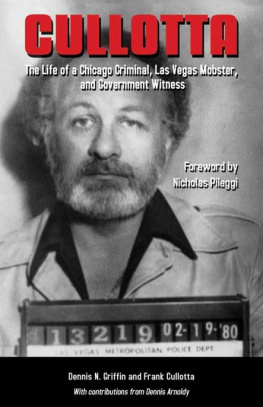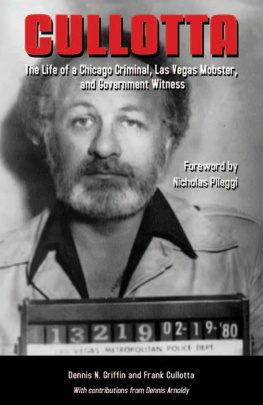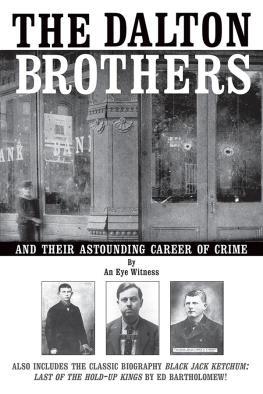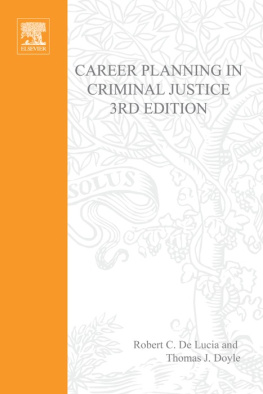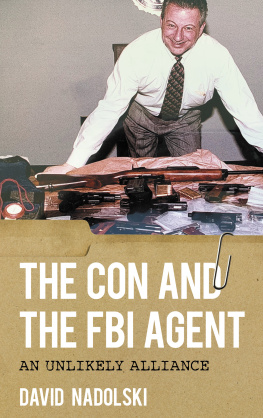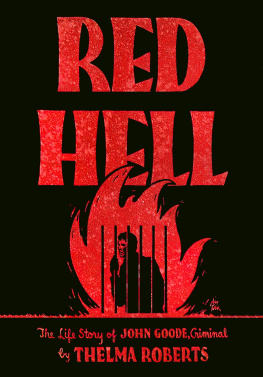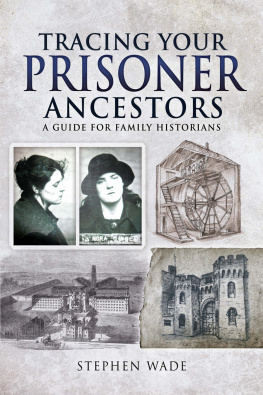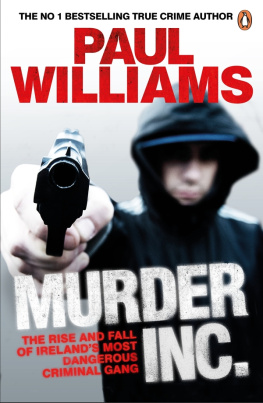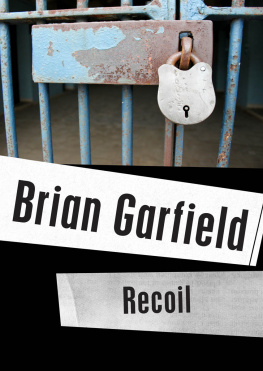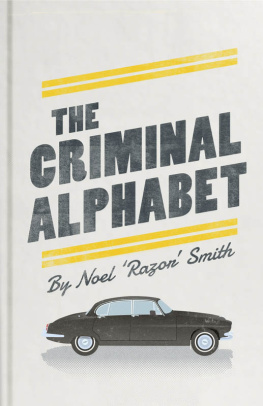CULLOTTA
The Life of a Chicago Criminal, Las Vegas Mobster, and Government Witness
Dennis N. Griffin and Frank Cullotta
With contributions from Dennis Arnoldy
Huntington Press
Las Vegas Nevada
Cullotta: The Life of a Chicago Criminal, Las Vegas Mobster, and Government Witness
Published byHuntington Press3665 Procyon StreetLas Vegas, NV 89103Phone (702) 252-0655e-mail: books@huntingtonpress.comCopyright 2007, Dennis Griffin, Frank CullottaISBN: 978-0-929712-96-3Design & Production: Laurie ShawPhoto Credits: Frank Cullotta, Dennis Arnoldy, Kent Clifford, Dennis N. Griffin, Gene Smith, Illinois Department of Corrections, Las Vegas Review-Journal , Las Vegas Metropolitan Police Department
All rights reserved. No part of this publication may be translated, reproduced, or transmitted in any form or by any means, electronic or mechanical, including photocopying and recording, or by any information storage and retrieval system, without the express written permission of the copyright owner.
Dedication
To the memory of my mother Josephine, who passed away in 1990. And to Ashley, my granddaughter, who left us in 2005. She was the light of my life.
Frank Cullotta
Acknowledgments
The information contained in this book was derived from many sources, primarily from Frank Cullotta himself and retired FBI agent Dennis Arnoldy. But there were many others who contributed to this project and I want to mention and thank them here. They include, but are not limited to, former Clark County Sheriff John McCarthy, Commander Kent Clifford, Detective David Groover and Lt. Gene Smith, former Strike Force Special Attorney Stanley Hunterton, and former FBI agents Joe Yablonsky, Charlie Parsons, Emmett Michaels, Donn Sickles, Lynn Ferrin, and Gary Magnesen.
The newspaper archives of the Las Vegas-Clark County Library District held stories from the Las Vegas Sun , The Valley Times, and Las Vegas Review - Journal that provided key information regarding events and incidents of the Tony Spilotro era in Las Vegas. A series of 1983 articles by Michael Goodman of the Los Angeles Times further illuminated those times. My special thanks go out to Las Vegas TV station KVBC for allowing the use of their investigative report of Tony Spilotros trial for the killings of Billy McCarthy and Jimmy Miraglia (the M&M Murders).
The Illinois Police and Sheriffs News Web site www.ipsn.org provided a wealth of information relating to organized-crime history in both Chicago and Las Vegas. The well-researched book Of Rats and Men (John L. Smith) was an invaluable resource. The movie Casino in which actors Joe Pesci and Robert De Niro portray characters based on Tony Spilotro and Frank Lefty Rosenthal proved to be extremely informative.
Others deserve mention, but for various reasons they desire to stay in the background. Respecting their wishes, they will remain nameless, but not unappreciated.
Denny Griffin
Contents Part OneFrom the Windy City to Sin CityMurder in Las VegasThe Early YearsBigger ThingsThe M&M BoysCrime WaveIn and Out of PrisonThe Straight Life FailsPart TwoLas VegasTogether AgainThe LawThe Beat Goes OnWarning Signs and Murder PlotsBerthasPart ThreeWitness Protection and BeyondSwitching SidesThe End of Tony SpilotroLooking BackWhere Are They Now?Surprise Indictments
Foreword
Frank Cullotta is the real thing.
I found that out when I was working on Casino , a book about the skim at the Stardust Hotel in Las Vegas. The story was about Anthony Spilotro, the mob boss of Las Vegas, and his relationship with Frank Rosenthal, the man who ran the mobs casinos. Cullotta was an invaluable source for me, because by the time I started writing the book, Spilotro had been murdered and Rosenthal, whod miraculously survived getting blown up in his car, was reluctant to give interviews.
But Frank Cullotta was alive and hed not only known all of the major characters central to the book, hed been one of them. He and Spilotro had been boyhood pals back in Chicago and it was Spilotro who convinced Cullotta to migrate west to a felony paradise. Cullotta had run the robbery, extortion, and murder departments for Spilotros Vegas mob.
Spilotro and Cullotta extorted cash from every illegal bookmaker, drug dealer, and burglar operating in Las Vegas. Those who refused wound up buried in the desert. Soon, no one refused and Spilotro became the indisputable boss of Las Vegas.
The police called Cullottas high-tech burglary crew The Hole in the Wall Gang, due to their penchant for breaking into buildings by blasting through walls.
The gang operated with very little trouble for years. Ultimately, however, one of the crew turned police informant to stay out of jail. He blew the whistle and Cullotta and his Hole in the Wall Gang were arrested in the middle of burglarizing Berthas, a large Las Vegas jewelry store.
The size and sophistication of the Cullotta crew surprised many in Las Vegas, especially when it was revealed that Cullotta had access to all the local police and FBI radio frequencies, not to mention a former Las Vegas police sergeant stationed outside Berthas as a lookout. While sitting in jail, Cullotta concluded that hed been set up by Spilotro to take a hard fall. After much agonizing, he decided to roll and testify against his former partners and friends.
By the time I contacted the Justice Department, Cullotta had already testified and served his time. He was now a free man. The only way for me to personally contact him was through Dennis Arnoldy, the FBI agent who had debriefed Cullotta in safe houses and federal prisons.
Arnoldy said he couldnt guarantee anything. Cullotta was in the Federal Witness Program living somewhere in America. But Arnoldy did say hed somehow get Cullotta my number.
When Cullotta called the next day, I was surprised to find that he wasnt hiding somewhere in America. In fact, he was in Las Vegas, the city where some of the most dangerous men in the state had already tried to kill him. He suggested that we meet in the morning in the parking lot of a Las Vegas shopping mall not far from the Strip.
The next morning I was there. No Cullotta. I checked my watch. He was five minutes late. Then, suddenly, Cullotta appeared. He just popped up. I was startled. I didnt see him coming until he was right on top of me. He stood close. He was solidly built and wore a small narrow-brimmed canvas rain hat. I was even more surprised when I realized he was alone. No federal marshals or FBI agents were watching his back. He leaned against a car fender and listened to my pitch about the book. He agreed to meet again, but mostly he said he wanted to make sure I got it right, especially the part about why he decided to testify against his former pals.
Cullotta turned out to be an invaluable resource. His memory was phenomenal. Hes the kind of person who remembers his license-plate numbers from decades ago, and this is a man who usually owned three or four cars at once. Equally important to me, Cullotta had been either a participant in or an observer of most of the books important events. He either set up or committed robberies and murders. He was often the third person in the room during domestic disputes between Spilotro, Rosenthal, and Rosenthals wife, with whom Spilotro was having an affair. In fact, Spilotros fear that Cullotta would report back to the bosses in Chicago, whod forbidden the affair, caused Spilotro to try and kill Cullotta. The failed murder attempt turned Cullotta into a government witness.
One of a non-fiction writers major concerns is knowing if the people youre interviewing are telling the truth. That problem becomes even more acute when dealing with cops, lawyers, and crooks, to whom lying is not unknown.
In Cullottas case, however, hed already been debriefed by the FBI and testified under oath in court about everything we were discussing, which could all be checked in the public record or in the volumes of FBI summaries. I felt confident that Cullotta was telling the truth, because his extraordinary immunity deal depended upon it. Cullottas freedom would end the minute he was caught in a lie and hed immediately be sent to prison, where he was bound to get killed. Therefore, I was in the unique position of interviewing someone whose life literally depended upon his telling the truth.

